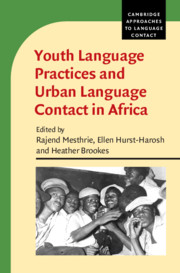12 results
8 - Authenticity and the Object of Analysis:
-
-
- Book:
- Youth Language Practices and Urban Language Contact in Africa
- Published online:
- 20 August 2021
- Print publication:
- 09 September 2021, pp 182-200
-
- Chapter
- Export citation
Contributors
-
- Book:
- Youth Language Practices and Urban Language Contact in Africa
- Published online:
- 20 August 2021
- Print publication:
- 09 September 2021, pp xi-xiv
-
- Chapter
- Export citation
Contents
-
- Book:
- Youth Language Practices and Urban Language Contact in Africa
- Published online:
- 20 August 2021
- Print publication:
- 09 September 2021, pp vii-viii
-
- Chapter
- Export citation
Series Editor’s Foreword
-
- Book:
- Youth Language Practices and Urban Language Contact in Africa
- Published online:
- 20 August 2021
- Print publication:
- 09 September 2021, pp xv-xviii
-
- Chapter
- Export citation
Copyright page
-
- Book:
- Youth Language Practices and Urban Language Contact in Africa
- Published online:
- 20 August 2021
- Print publication:
- 09 September 2021, pp vi-vi
-
- Chapter
- Export citation
Preface
-
- Book:
- Youth Language Practices and Urban Language Contact in Africa
- Published online:
- 20 August 2021
- Print publication:
- 09 September 2021, pp xix-xx
-
- Chapter
- Export citation
Introduction
-
-
- Book:
- Youth Language Practices and Urban Language Contact in Africa
- Published online:
- 20 August 2021
- Print publication:
- 09 September 2021, pp 1-12
-
- Chapter
- Export citation
Abbreviations
-
- Book:
- Youth Language Practices and Urban Language Contact in Africa
- Published online:
- 20 August 2021
- Print publication:
- 09 September 2021, pp xxi-xxii
-
- Chapter
- Export citation
Index
-
- Book:
- Youth Language Practices and Urban Language Contact in Africa
- Published online:
- 20 August 2021
- Print publication:
- 09 September 2021, pp 201-206
-
- Chapter
- Export citation
Tables
-
- Book:
- Youth Language Practices and Urban Language Contact in Africa
- Published online:
- 20 August 2021
- Print publication:
- 09 September 2021, pp x-x
-
- Chapter
- Export citation
Figures
-
- Book:
- Youth Language Practices and Urban Language Contact in Africa
- Published online:
- 20 August 2021
- Print publication:
- 09 September 2021, pp ix-ix
-
- Chapter
- Export citation

Youth Language Practices and Urban Language Contact in Africa
-
- Published online:
- 20 August 2021
- Print publication:
- 09 September 2021



